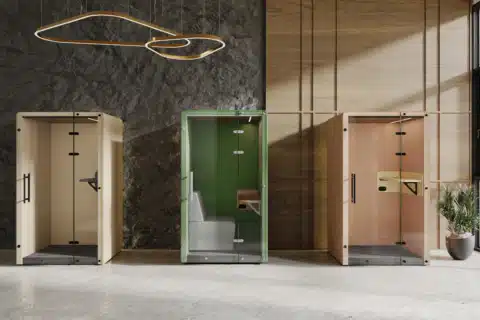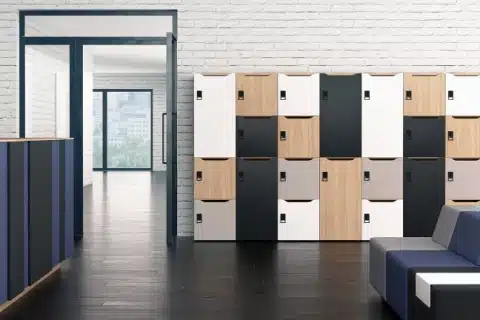Request a Quote
16 Manor Farm Barn
Fox Road, Framingham Pigot
Norwich
Norfolk
NR14 7PZ
Distribution Centre
Gordon Francis House
19 Mobbs Way, Business Park
Lowestoft
Suffolk
NR32 3BE
Office spaces have evolved significantly in recent years, particularly post-pandemic. With more people working hybrid schedules and turning their homes into part-time workspaces, the need for an engaging and comfortable office environment is greater than ever.
Why would anyone choose to go into a dull, uninspiring office when they can work comfortably from their own sofa? That’s why, in 2024, it’s crucial to refresh your space to make it both functional and appealing to your employees.
Today, flexible and adaptive workspaces, along with technology-driven solutions, are key to maintaining a happy, productive workforce and enhancing their well-being.
In this blog post, we explore the top trends of 2024 in planning and equipping your workplace for success.
Flexible and adaptive workspaces
Offices are shifting towards spaces that are easily reconfigured and flexible. Ensuring these spaces are appropriate for multi-uses is key, such as meeting spaces turned into a solo working space.
Accommodating different working styles and team sizes, utilising office furniture that can grow with your organisation.
Key features and products:
Modular furniture such as Pledge Chair’s Pontoon Sofa System, movable walls or acoustic screens, and tech-integrated meeting rooms.
Considerations when choosing an office space:
Look for open floor plans, ample power outlets and strong Wi-Fi infrastructure that can support flexible office setups.

Focus on wellness and sustainability
Over the past few years, employee health and well-being have become top priorities in the workplace. According to Mental Health UK’s Burnout Report 2024, which surveyed 2,060 adults through a YouGov poll, 91% of UK adults experienced high or extreme levels of pressure or stress in the past year. This resulted in one in five workers (20%) needing to take time off work due to burnout. These statistics highlight the critical importance of supporting your team’s physical and mental health, starting with creating a healthy and supportive workspace.
In addition to well-being, sustainability has also become a key concern for employees. A greener, healthier workplace benefits both the environment and the people in it, whether through initiatives like going paperless or incorporating more greenery into the office space.
Key features and products:
Biophilic design elements, standing desks such as Formetiq’s Alto Sit/Stand Desks, ergonomic furniture, air purifiers and energy-efficient appliances.
Considerations when choosing an office space:
Natural lighting, availability of outdoor spaces, green certifications (BREEAM) and proximity to public transportation or bike paths.
Collaborative vs. private spaces
There needs to be a balance between open, collaborative spaces and areas where employees can work privately or in small groups. Accommodating the different working styles of your team is crucial for reducing overwhelm and boosting productivity.
There’s nothing more frustrating than having to hold a meeting in a noisy office or, conversely, trying to focus on your work while being distracted by a nearby conversation! By designing spaces that cater to both collaboration and individual work, you can create a more harmonious and effective work environment.
Key features and products:
Noise-reducing pods such as JDD’s Bob Acoustic Meeting Pod, quiet zones and collaborative hubs.
Considerations when choosing an office space:
Ensure there is a mix of spaces for different types of work and consider the acoustics of the office.

Inclusivity and accessibility
In today’s evolving work landscape, designing office spaces that prioritise inclusivity and accessibility is no longer a luxury but a necessity. Creating an environment that is welcoming, accessible and comfortable for all employees not only fosters a culture of inclusivity but also significantly enhances employee satisfaction and productivity.
Key features and products:
Adjustable workstations, monitor arms, desktop/under-desk power supply such as Powerlink Under-desk Power Supplies, accessible entrances and sensory-friendly environments.
Considerations when choosing an office space:
Look for buildings that are accessible and have the flexibility to accommodate the needs of all employees.

Remote-work integration
With the rise of hybrid work models, offices must seamlessly integrate remote work into their operations. This means providing the necessary tools, technologies and infrastructure to support employees who work from home, in the office or any location in between!
Key features and products:
High-quality video conferencing/meeting equipment such as an Office Media Wall, collaborative software solutions and remote workstations.
Considerations when choosing an office space:
Assess the availability of spaces designed for virtual meetings and the strength of digital connectivity options.
By creating spaces that reflect the latest trends, you can enhance your team’s productivity and satisfaction while fostering a positive company culture that puts employees first.
iQ Workspace are dedicated to planning unique spaces from the ground up, collaborating with their customers to deliver exactly what they’re looking for within their budget.
Are you moving office? Or looking for a refresh? We’d be happy to talk. You can book a free consultation with us below.
Ready to start your next project?
Book a free consultation or get in touch.
















